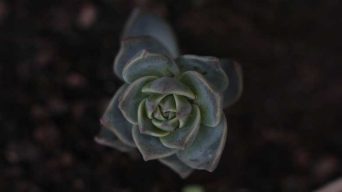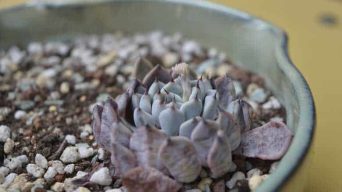The overwatered cactus is a common problem for those who grow succulents as houseplants.
The condition usually occurs when the soil is overwatered, but it can also happen if there has been too much humidity in the air or stopped up drainage pipes.
If you notice your cactus sitting in water or see roots that are beginning to drown, you should fix this before it becomes chronic and permanently damages your plant’s health.
This article will help you identify how an overwatered cactus develops, what may be causing it, and what you can do about it!
What Are the Risks of Overwatering a Cactus?
Overwatering a cactus plant is one of the most common problems that occur with these plants.
It can cause root rot, cactus fungus, overwatering cactus diseases, and other problems that will eventually kill the plant if not treated properly.
The main problems with overwatering cacti are root rot, fungus problems, bacteria problems, and even insect infestations.
Root Rot
Overwatering cacti can cause the roots to rot.
It is important not to overwater these plants because when they sit in water for too long, the roots will deteriorate and become soft, making it hard for them to absorb nutrients from the soil.
Fungus Problems
If your cactus develops root rot from excessive watering, it fosters an environment conducive to the easy growth of fungi, exacerbating the issue.
Allowing fungal infections like powdery mildew or gray mold to grow on your plant leaves, stems or flowers causes disfiguration and even death if left untreated.
Bacteria Problems
The bacteria associated with rotting cacti multiply quickly within wet environments.
When a cactus sits in water for too long, the bacteria resulting from this can be as deadly as fungus and root rot.
Insect Infestations
Certain insects like mealybugs or thrips love to live on plants with wet roots.
If you have been overwatering your succulent, these bugs will take advantage of your plant’s weakened state and infest it, laying eggs inside the plant tissue itself.
These larvae eat away at the soft insides of leaves, stems, or even flower buds, making it impossible to save your plant once things get out of control.
How Does Overwatering a Cactus Occur
The most common way people overwater their cacti is by watering them too often and giving them water at the wrong times of the year.
Another potential problem is that the soil has too much water because it’s not draining properly.
Cacti need very little water when they are in their growing season, which is spring through fall.
During this time of year, occasional watering will be helpful because it helps the plants retain their flowers better.
However, overwatering can still cause problems, so you should never let them sit in puddles or soak up water like sponges if they get watered more than once every few weeks during these months.
Cacti are succulents and need little moisture, so watering them more than twice a month in winter is usually overwatering. If you’re doing this, stop! Consider moving your cactus to a pot with better drainage.
The other thing that causes the overwatering of cacti is allowing their pots to sit in water for hours or days after they’ve watered them.
This should never happen because it will rot its roots and kill your plant quickly if allowed to continue unchecked.
Finally, there can be another cause, like when you’re in a humid climate, and your cactus sits in water vapor all day, contributing to overwatering.
How To Identify If Your Cactus Is Overwatered?
If you notice that your cactus plant looks limp, not standing straight up, and the soil is very wet and doesn’t drain, it’s most likely because it is overwatered.
If the soil feels squishy, that means there is too much water in the pot, and if you feel or see mold on top of the soil, this also indicates that your plant has been overwatered.
Cacti like to dry out between waterings. If the cactus sits in wet soil for too long, it can develop root rot. This means that there’s a possibility your plant may die if you don’t act fast enough.
It may be difficult to tell if your cactus is overwatered. However, some signs can help you identify if your cactus is overwatered.
Signs of Overwatering
An overwatered cactus plant can look healthy one day and then completely shrivel up the next.
It’s essential to catch this problem early before it gets out of control. If you notice your cactus is starting to display any of these signs, there is a good chance that your plant has been overwatered.
1. Soil Is Soggy And Soaked To The Touch
Soggy soil means there is too much water in the pot.
This will eventually lead to root rot, and your plant will die if you don’t act fast enough.
Soggy soil also makes it difficult for air to circulate around the roots, making it harder for cacti to absorb oxygen which can suffocate the roots leading them to die off.
2. Cacti Are Leaning Or Falling Over
It’s essential to keep an eye out for this sign because if the cactus begins leaning over, it will eventually start falling over.
It can also indicate that there is insufficient support or weight of soil pushing down on the plant, causing it to lean and fall over.
If your cactus begins leaning and falls over, this is a sign your plant has been overwatered.
Leaning cacti can also be caused by uneven growing conditions or incorrect light exposure. Still, if you notice that the cactus in one location leans more than another, then it’s likely to be due to soil imbalance.
If all of your plants lean towards the same side, it’s more than likely due to uneven soil.
3. Cacti Leaves Are Wilting
If too much water is in the pot, your cactus leaves will begin wilting and drooping downwards.
This happens because damaged roots cannot absorb water, causing them to suffocate, which leads to the plant’s inability to get the water it needs.
Wilting leaves can also indicate that there is too much light exposure. If the cactus is placed in direct sunlight, it could cause its leaves to wilt and droop downwards.
However, wilting due to overwatering will happen faster than over-exposure to sun rays.
4. Soil Is Squishy
If you feel soil that feels squishy, it means there is too much water in the pot.
Moisture-loving pests like mealybugs, scale insects, and spider mites are more likely to develop on cacti with moist or wet conditions, which can lead them to destroy your plant if not taken care of in time.
Pest insects are more likely to attack cacti when the soil has too much moisture.
5. The Soil Has Mold
Mold can grow on top of your potting soil if overwatered. This means insufficient air circulation leads to moist conditions for mold growth.
Mold can also signify that other insects, such as mealybugs, scale insects, or spider mites, will eat away at your cacti until nothing is left.
If you see mold on top of the soil, your plant has been overwatered.
6. Cacti Have Dropped Or Shed Some Of Its Spines
Dropping or shedding some of its spines is a sign that the cactus has been overwatered.
Dropping spines can also be a sign that your plant has been exposed to cold temperatures, other forms of stress, or an insect infestation.
If the cactus drops some spines while others are still intact, this is more than likely due to overwatering.
7. Cacti Begin to Change Color
Overwatered cacti will begin to turn yellow.
This is a sign that it has been overwatered for too long, and the roots have begun to die off.
If you notice your cacti begin to change color, this means that it has been overwatered; turning yellow indicates a lack of nutrients.
If the cactus is turning yellow, it means that it has been overwatered for too long, and the roots have begun to die off.
How To Save an Overwatered Cactus Plant
When you have an overwatered cactus, there are a few ways to go about treating it.
Depending on the severity of your plant’s condition, there are a few options you can choose from.
Transplanting and Potting Soil Replacement
If you have an overwatered cactus, it might be worth checking to see if its roots are rotted.
If they’re moldy or soft, that means that they’ve been rotting, and the cactus will need to be repotted and planted in fresh soil.
The old, moldy potting soil should also be thrown out as it can cause other plants you plan on keeping healthy to become sickly as well.
Remove Affected Roots
If your root system is badly damaged but your plant isn’t, you can try to remove the affected roots carefully.
Be careful with this process, as you could damage the rest of your cactus’s root system if you’re unsure what to do.
If it is just a little bit rotted, try cutting out at least an inch from its roots and repotting in fresh soil or replacing the pot altogether if necessary.
Rotten roots should be trimmed away from the plant’s root ball with a sharp, sterilized blade.
This is a little difficult, but it’s possible to do with enough care and patience.
Let It Sit In The Sun With No Water
If your cactus has been overwatered, you should set it out in the sun for a few hours without giving it any water or letting any rainfall on its leaves.
This will help dry up some of the root system so that when you go to repot it, there won’t be as much molding going on inside of its potting soil.
Once this period has passed, give your plant fresh, well-drained potting mix, place it in an area where water isn’t splashing all over the leaves, and make sure not to overwater it again.
If you follow these steps, your plant should grow back quickly and be as good as new in no time!
Cutting Back On Water
You can also decide not to repot your cactus and simply cut back on how much water you’re giving it.
This is a pretty good option for those who don’t want to have to deal with repotting their cactus and potentially having it rot again.
Keeping your plant small by cutting back on water ensures that there’s less chance of overwatering the roots in the future.
This is an option for plants that aren’t in too terrible of a condition but still need some recovery time after being overwatered.
If this doesn’t help, the plant will likely be beyond saving and will have to go.
Get Rid of Damaged Leaves
If you have a plant that has survived being overwatered, but its leaves are either molding or black, it’s best to cut them off.
This will remove the risk of bacteria spreading from this area through your entire cactus and cause more damage.
If there are tiny spots of rot on some leaves, you can leave them be since they’ll likely fall out anyway during natural leaf drop.
Just make sure not to get any water on these areas so that new growth doesn’t become damaged as well!
Don’t Do Anything
If your cactus is really far gone, it might be worth considering letting it go.
Sometimes the stress of being overwatered can kill a plant, and trying to save an already dying plant isn’t always the best choice in that situation.
If you decide not to repot or cut back on the water but still believe there’s hope for your plant, wait until its leaves begin falling off naturally before throwing out its potting soil.
The leaf loss will likely indicate how much damage has been done inside the root system, so this way, you’ll know if there’s any point in bringing new life into it again.
How To Prevent Overwatering Cacti?
There are several steps you can take to prevent overwatering your cactus.
You should first choose a container with appropriate drainage holes so that excess water can drain out of the pot once it has reached the rim.
If there are no drainage holes, even if they have been drilled by someone else, be sure to drill some yourself to allow excess water to drain out.
Secondly, be sure that the cactus is planted in a porous soil with good drainage properties so that water can easily drain out of the pot.
You usually want to use a cactus soil mix as it has the proper drainage properties.
Finally, try not to water your cactus too frequently and allow the soil to dry out between watering.
You can know whether it needs water by sticking your finger in the soil. If dry, give it a good soak and let any excess drain out of the container or pot.
This will help promote root growth and health in the plant.
Watering every week or two should be enough for healthy growing cacti that aren’t planted in an excessively small container with limited soil volume.
If you follow these three steps, your cactus should have a better chance of staying healthy and not suffering from overwatering.
Final Thoughts
Overwatered and underwatered cacti are common problems in the home and garden.
Cactus are well-known for their ability to store moisture to survive prolonged periods of drought conditions. However, this can also be the reason why they are so susceptible when it comes to overwatering.
When cacti are given too much water, they rot and become mushy, ultimately leading to death.
Understanding the frequency at which a cactus should be watered is crucial to prevent overwatering.
Cacti require little amounts of water; if too much is applied, the plant will begin to lose its capacity/ability to absorb any more liquid because it has already reached its saturation point.
Learning to identify it can prevent future incidents that will damage your plant.
If you believe your cactus is already affected by overwatering, then treatment and recovery are possible.








